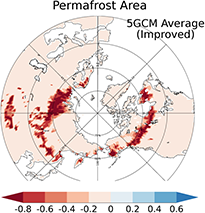** Progress in Earth and Planetary Science is the official journal of the Japan Geoscience Union, published in collaboration with its society members.
Gallery View of PEPS Articles
Research
Atmospheric and hydrospheric sciences
202011202011
Model improvement and future projection of permafrost processes in a global land surface model
Tokuta Yokohata, Kazuyuki Saito, Kumiko Takata, Tomoko Nitta, Yusuke Satoh, Tomohiro Hajima, Tetsuo Sueyoshi, Go Iwahana
Climate change, Permafrost degradation, Global land surface model, Model development
Figure 1. Permafrost area of the historical model simulation (blue) and observation (outlined in black). The historical simulation was performed with the MIROC atmospheric forcing. The permafrost area is determined using the soil temperature for the year 2000. The observed permafrost area is from Brown et al. 1998 (Circum-arctic map of permafrost and ground ice conditions. National Snow and Ice Data Center, Digital media, Boulder, CO).
Changes in the permafrost distribution projected by the study’s future projection simulations. The improved version of the global land surface model is used. The current permafrost area is set at 1.0. Average values for the simulations with atmospheric forcings by the five GCMs are plotted. The difference between the average for 2081-2090 and 2006-2015 under RCP8.5 was calculated.
To date, the treatment of permafrost in global climate models has been simplified due to the prevailing uncertainties in the processes involving frozen ground. In this study, we improved the modeling of permafrost processes in a state-of-the-art climate model by taking into account some of the relevant physical properties of soil such as changes in the thermophysical properties due to soil freezing. As a result, the improved version of the global land surface model was able to reproduce a more realistic permafrost distribution at the southern limit of the permafrost area by increasing the freezing of soil moisture in winter. The improved modeling of permafrost processes also had a significant effect on future projections. Using the conventional formulation, the predicted cumulative reduction of the permafrost area by year 2100 was approximately 60% (40–80% range of uncertainty from a multi-model ensemble) in the RCP8.5 scenario, while with the improved formulation, the reduction was approximately 35% (20–50%). Our results indicate that the improved treatment of permafrost processes in global climate models is important to ensuring more reliable future projections.
#: https://ads.nipr.ac.jp/node/dagik/?type=MIROC5/PERMAFROST_SEP







